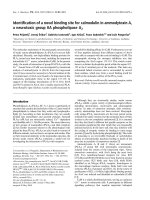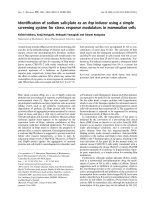Vector sum phase shifter using a quadrature magic t for application in polarization control
Bạn đang xem bản rút gọn của tài liệu. Xem và tải ngay bản đầy đủ của tài liệu tại đây (8.47 MB, 144 trang )
VECTOR SUM PHASE SHIFTER USING A QUADRATURE
MAGIC-T FOR APPLICATION IN POLARIZATION
CONTROL
LU WEI JIA
(B.Eng. (Hons.), NUS)
A THESIS SUBMITTED
FOR THE DEGREE OF MASTER OF ENGINEERING
DEPARTMENT OF ELECTRICAL AND COMPUTER ENGINEERING
NATIONAL UNIVERSITY OF SINGAPORE
2014
Declaration
I hereby declare that this thesis is my original work and it has been written by me
in its entirety. I have duly acknowledged all the sources of information which
have been used in the thesis. This thesis has also not been submitted for any
degree in any university previously
_________________________
LU WEI JIA
9 April 2014
Acknowledgement
I wish to express my sincere gratitude to my supervisor, Associate
Professor Koen Mouthaan, for his support, encouragement, understanding and
guidance that made this dissertation possible. Without him pointing me in the
right direction, this project would not have been completed.
I would like to thank Mr Joseph Ting Sing Kwong and Dr. Chio Tan Huat
from NUS Temasek Laboratories (TL). Without their understanding and support
in my studies, it will not be possible for me to complete my part-time master of
engineering while working.
Special thanks also to Madam Lee Siew Choo in the Microwave Research
Lab (NUS) and Mr. Tan Peng Khiang in the Antenna Group (NUS TL). Without
Madam Lee’s technical support in fabricating the circuits and Peng Khiang’s
knowledge in the available fabrication technologies and proper handling of the
test equipment, the prototype would not have been built and tested.
In addition, I also thank Mr. Tang Xingyi and Mr. Ray Fang for their
valuable discussion and assistance in every aspect of this project. Their readiness
to share their knowledge and expertise has greatly benefitted my learning.
I also appreciate my colleagues at NUS TL for their understanding and
encouragement they have given to me along the way. Last but not least, I would
like to take the opportunity to thank my parents and my little brother for their love
and support through the whole journey.
i
Table of Contents
Acknowledgement ................................................................................................... i
Table of Contents .................................................................................................... ii
Summary ................................................................................................................ vi
List of Tables ....................................................................................................... viii
List of Figures ........................................................................................................ ix
List of Symbols ..................................................................................................... xv
Chapter 1 Introduction ............................................................................................ 1
1.1
Background ................................................................................ 1
1.1.1
Polarization of EM waves .......................................................... 2
1.1.2
Mathematical representation of polarization .............................. 3
1.1.3
Polarization control methods ...................................................... 5
1.2
Motivation ................................................................................ 10
1.3
Thesis organization................................................................... 12
1.4
Original contributions............................................................... 13
Chapter 2 Two-way vector sum phase shifter....................................................... 15
2.1
Introduction .............................................................................. 15
2.2
Novel two-way vector-sum phase shifter ................................. 16
2.2.1
Block diagrams ......................................................................... 16
ii
2.2.2
Signal flow analysis.................................................................. 18
2.2.3
Mathematic analysis ................................................................. 21
2.3
Ideal ADS simulations.............................................................. 23
2.4
Conclusions .............................................................................. 25
Chapter 3 Quadrature Magic-T ............................................................................. 26
3.1
Introduction .............................................................................. 26
3.1.1
Classification of hybrids ........................................................... 26
3.1.2
Examples of a hybrid ................................................................ 27
3.1.3
Definition of a 180° hybrid ...................................................... 29
3.1.4
Characteristics of a typical 180° hybrid ................................... 31
3.1.5
Objectives ................................................................................. 31
3.2
180° hybrid ............................................................................... 32
3.3
Novel Quadrature Magic-T ...................................................... 35
3.3.1
Definition of Quadrature Magic-T ........................................... 35
3.3.2
Preliminary design of a Quadrature Magic-T........................... 36
3.3.3
Improved Quadrature Magic-T ................................................ 39
3.4
HFSS simulation....................................................................... 42
3.5
Fabrication and measurement results ....................................... 49
3.6
Analysis and conclusions ......................................................... 54
Chapter 4 Broadband 90° Phase shifter ................................................................ 56
iii
4.1
Introduction .............................................................................. 56
4.2
Broadband 90° Phase shifter .................................................... 58
4.3
ADS simulation and design ...................................................... 59
4.4
HFSS simulation and implementation ...................................... 62
4.5
Results and analysis.................................................................. 64
4.6
Conclusions .............................................................................. 68
Chapter 5 Control circuits ..................................................................................... 69
5.1
Introduction .............................................................................. 69
5.2
Variable gain amplifier prototype ............................................ 69
5.3
RF switch prototype ................................................................. 78
5.4
Conclusions .............................................................................. 87
Chapter 6 Implementation and measurement ....................................................... 88
6.1
Introduction .............................................................................. 88
6.2
Fabricated PCB board .............................................................. 88
6.3
Measurement results and analysis ............................................ 91
6.4
Conclusions ............................................................................ 110
Chapter 7 Polarization controller architecture .................................................... 112
7.1
Introduction ............................................................................ 112
7.2
Proposed polarization controller architecture......................... 112
7.3
Comparison of the polarization control circuits ..................... 114
iv
7.4
Polarization control circuits in phased arrays......................... 117
7.5
Conclusions ............................................................................ 119
Chapter 8 Conclusions and recommendations .................................................... 120
8.1
Conclusions ............................................................................ 120
8.2
Recommendations .................................................................. 121
Bibliography ....................................................................................................... 123
v
Summary
Polarization refers to the orientation of the electric field as electromagnetic
(EM) waves propagate through space. The commonly used polarizations include
vertical (V), horizontal (H), slant +/-45°, left hand circular polarization (LHCP)
and right hand circulator polarization (RHCP). Its application can be found in
both military and commercial systems. In military radar systems, it is used for
target identification; in electronic warfare systems, it is used for jamming and
counter-jamming. Commercial systems use it to increase the communication
capacity through polarization diversity. Therefore, the ability to have polarization
diversity is greatly desired.
An electromagnetic wave is transmitted or received in a polarization that
is determined by the antenna. The polarization, however, can be controlled when
a polarization controller is used with a dual-polarized antenna. The polarization
controller changes the polarization by varying the amplitude and the phase of the
signal feed to the antenna. It employs either an RF switch, or a hybrid circuit and
phase shifters to control the signals to or from the antenna.
The aim of this thesis is to investigate and implement a wideband two-way
vector sum phase shifter for the application in polarization control. A key novel
development is the Quadrature Magic-T circuit discussed in Chapter 3. A typical
magic-T produces 0° and 180° phase difference between the two collinear arms
when the sum-port and the delta-port are excited respectively. In the Quadrature
Magic-T circuit, besides having the typical magic-T response, the input phase
vi
difference between the sum- and delta-ports needs to be 90° apart in order to
achieve excitation in only one of the collinear arms. This feature ensures that the
signals at the two outputs are vector summed together when both the sum-port
and delta-port are excited in phase. The pair of output signals has equal amplitude
but variable phase difference. As such, the Quadrature Magic-T is a crucial
component in the proposed two-way vector sum phase shifter design.
The proposed two-way vector sum phase shifter with 180° phase tuning
uses a power divider, a Quadrature Magic-T and two variable gain amplifiers. To
extend the phase coverage, two broadband 90° phase shifters and four RF
switches are included. The individual components are separately designed and
tested to verify their performance. The final design of the two-way vector sum
phase shifters has a 360° phase tuning from 2 GHz to 6 GHz. When connected to
a dual-polarization antenna arranged in +/- 45°, the circuit is able to achieve the
standard V, H, RHCP and LHCP polarizations with full RF power.
Besides polarization control, the circuit developed in this thesis is also
useful for beam steering in a phased array antenna and phase modulation in a
communication system. With further optimization and size reduction, the circuit
has the potential of becoming a new device in the range of microwave and
millimeter wave.
vii
List of Tables
Table 1-1: Main polarizations. ................................................................................ 4
Table 1-2: Four main polarizations with full power. ............................................ 10
Table 5-1: VGA performance comparison. .......................................................... 70
Table 6-1: Switch settings and the corresponding phase output. .......................... 91
Table 6-2: A performance comparison of the 360° phase shifters...................... 109
Table 7-1: Achievable polarizations through spatial power combining. ............ 114
Table 7-2: A comparison of the polarization control circuits. ............................ 117
viii
List of Figures
Fig. 1-1: Single polarization horn antenna. ............................................................. 6
Fig. 1-2: Dual linear polarization horn antenna. ..................................................... 6
Fig. 1-3: Circular polarization spiral antenna. ........................................................ 7
Fig. 1-4: Dual linear polarization array taken from [7]. ......................................... 7
Fig. 1-5: Polarization controller architecture. ......................................................... 9
Fig. 2-1: Proposed block diagram of the two-way vector-sum phase shifter. ...... 16
Fig. 2-2: Amplitude and phase changes in Part A. ............................................... 18
Fig. 2-3: Resultant signals at out1 (Sout1) and out2 (Sout2) versus amplitude of
signals due to sum-port (Ssum) and delta-port (Sdelta). ........................................... 19
Fig. 2-4: Phase difference coverage before and after Part B circuit. .................... 20
Fig. 2-5: Phase difference between port 2 and port 3 (ideal). ............................... 24
Fig. 2-6: |S21| and |S12| for all switch states (ideal)................................................ 24
Fig. 2-7: Amplitude imbalance for all switch and V1 states (ideal). .................... 25
Fig. 3-1: Multistage directional coupler................................................................ 27
Fig. 3-2: 3 dB tandem coupler. ............................................................................. 28
Fig. 3-3: Broadband 180° hybrid [21]. ................................................................. 28
Fig. 3-4: Block diagram of a 180° hybrid and its port definition. ........................ 30
Fig. 3-5: (a) A typical 180° hybrid model and (b)-(d) its possible relative phases at
Port 2 and Port 3 when both sum and delta ports are excited. .............................. 31
Fig. 3-6: Simulated |S11|, |S22|, |S33| and |S44|. ........................................................ 32
Fig. 3-7: Simulated |S31| and |S12| for sum-port excitation. ................................... 33
Fig. 3-8: Simulated |S34| and |S24| for delta-port excitation. .................................. 33
Fig. 3-9: Simulated insertion phase. ..................................................................... 34
ix
Fig. 3-10: Simulated phase difference between the two output ports. .................. 34
Fig. 3-11: Definition of Quadrature Magic-T ....................................................... 36
Fig. 3-12: Quadrature Magic-T. ............................................................................ 37
Fig. 3-13: Phase response of the Quadrature Magic-T. ........................................ 38
Fig. 3-14: Cross-input phase difference of the Quadrature Magic-T.................... 38
Fig. 3-15: Simulated |S11|, |S22|, |S33| and |S44| of the improved Quadrature
Magic-T................................................................................................................. 39
Fig. 3-16: Simulated |S31|, |S21|, |S34| and |S24| of the improved Quadrature
Magic-T................................................................................................................. 40
Fig. 3-17: Simulated insertion phase for the improved Quadrature Magic-T....... 40
Fig. 3-18: Simulated improved cross-output phase difference. ............................ 41
Fig. 3-19: Simulated improved cross-input phase difference. .............................. 41
Fig. 3-20: HFSS model of a Quadrature Magic-T. ............................................... 43
Fig. 3-21: |S11|, |S22|, |S33| and |S44| simulated in HFSS. ........................................ 45
Fig. 3-22: |S31|, |S21|, |S34| and |S24| simulated in HFSS. ........................................ 45
Fig. 3-23: Amplitude imbalance simulated in HFSS. ........................................... 46
Fig. 3-24: |S41| and |S14| simulated in HFSS. ......................................................... 46
Fig. 3-25: Insertion phase simulated in HFSS. ..................................................... 47
Fig. 3-26: Cross-output phase difference simulated in HFSS............................... 47
Fig. 3-27: Cross-input phase difference simulated in HFSS................................. 48
Fig. 3-28: Photo of the fabricated Quadrature Magic-T circuit. ........................... 49
Fig. 3-29: Measured (solid line) and simulated (dotted line) |S11|, |S22|, |S33| and
|S44| of the Quadrature Magic-T. ........................................................................... 50
Fig. 3-30: Measured (solid line) and simulated (dotted line) |S31| and |S21| for the
sum-port excitation. .............................................................................................. 50
x
Fig. 3-31: Measured (solid line) and simulated (dotted line) |S34| and |S24| for the
delta-port excitation. ............................................................................................. 51
Fig. 3-32: Measured (solid line) and simulated (dotted line) |S41| and |S14|. ......... 51
Fig. 3-33: Measured (solid line) and simulated (dotted line) insertion phase
response................................................................................................................. 52
Fig. 3-34: Measured (solid line) and simulated (dotted line) cross-output phase
difference. ............................................................................................................. 52
Fig. 3-35: Measured (solid line) and simulated (dotted line) cross-input phase
difference. ............................................................................................................. 53
Fig. 3-36: Simulated |S11|, |S22|, |S33| and |S44| for different coupled line gap width.
............................................................................................................................... 54
Fig. 3-37: Simulated cross-input phase difference for different coupled line gap
width. .................................................................................................................... 55
Fig. 4-1: Topology of the bandpass and all-pass phase shifter [30]. .................... 59
Fig. 4-2: Simulated |S11| and |S22| of the phase shifter. ......................................... 60
Fig. 4-3: Simulated |S21| and |S43| of the phase shifter. ......................................... 60
Fig. 4-4: Amplitude imbalance between the two paths......................................... 61
Fig. 4-5: Simulated phase response of the phase shifter. ...................................... 61
Fig. 4-6: Phase difference between the two paths................................................. 62
Fig. 4-7: HFSS simulation model of the phase shifter. ......................................... 63
Fig. 4-8: Fabricated phase shifter.......................................................................... 63
Fig. 4-9: Simulated (dotted line) and measured (solid line) |S11| and |S22|............ 65
Fig. 4-10: Simulated (dotted line) and measured (solid line) |S33| and |S44|.......... 65
Fig. 4-11: Simulated (dotted line) and measured (solid line) |S21| and |S43|.......... 66
Fig. 4-12: Simulated (dotted line) and measured (solid line) amplitude imbalance.
............................................................................................................................... 66
Fig. 4-13: Simulated (dotted line) and measured (solid line) phase difference. ... 67
xi
Fig. 5-1: Suggested VGA biasing network [33]. .................................................. 71
Fig. 5-2: Photograph of the fabricated VGA prototype. ....................................... 71
Fig. 5-3: Measured |S11| of VGA1 under different control voltages. .................... 73
Fig. 5-4: Measured |S11| of VGA2 under different control voltages. .................... 73
Fig. 5-5: Measured |S21| of VGA1 under different control voltages. .................... 74
Fig. 5-6: Measured |S21| of VGA2 under different control voltages. .................... 74
Fig. 5-7: Measured |S22| of VGA1 under different control voltages. .................... 75
Fig. 5-8: Measured |S22| of VGA2 under different control voltages. .................... 75
Fig. 5-9: Measured |S12| of VGA1 under different control voltages. .................... 76
Fig. 5-10: Measured |S12| of VGA2 under different control voltages. .................. 76
Fig. 5-11: Measured S21 phase for VGA1. ............................................................ 77
Fig. 5-12: Measured S21 phase for VGA2. ............................................................ 77
Fig. 5-13: Block diagram of SKY13286-359LF switch [35]................................ 79
Fig. 5-14: Fabricated RF switch test board. .......................................................... 79
Fig. 5-15: Measured |S11|, |S22| and |S33| for S1. .................................................... 81
Fig. 5-16: Measured |S11|, |S22| and |S33| for S2. .................................................... 81
Fig. 5-17: Measured |S21| and |S31| for S1. ............................................................ 82
Fig. 5-18: Measured |S21| and |S31| for S2. ............................................................ 82
Fig. 5-19: Amplitude imbalance between |S21| at 0 V and |S31| at 5 V for S1. ...... 83
Fig. 5-20: Amplitude imbalance between |S21| at 0 V and |S31| at 5 V for S2. ...... 83
Fig. 5-21: Measured |S23| for S1............................................................................ 84
Fig. 5-22: Measured |S23| for S2............................................................................ 84
Fig. 5-23: Measured S21 (dotted line) and S31 (solid line) phase response for S1. 85
xii
Fig. 5-24: Measured S21 (dotted line) and S31 (solid line) phase response for S2. 85
Fig. 5-25: Phase difference of insertion states for S1. .......................................... 86
Fig. 5-26: Phase difference of insertion states for S2. .......................................... 86
Fig. 6-1: PCB layout of the two-way vector sum phase shifter. ........................... 89
Fig. 6-2: Photo of the fabricated polarization controller circuit. .......................... 90
Fig. 6-3: Measured phase difference at 4 GHz. .................................................... 92
Fig. 6-4: Measured amplitude imbalance for both Case A and B at 4 GHz. ........ 92
Fig. 6-5: Measured |S11| for Case A at 4 GHz. ...................................................... 93
Fig. 6-6: Measured |S11| for Case B at 4 GHz. ...................................................... 93
Fig. 6-7: Measured |S22| for Case A and B at 4 GHz. ........................................... 94
Fig. 6-8: Measured |S33| for Case A and B at 4 GHz. ........................................... 94
Fig. 6-9: Measured |S21| for Case A at 4 GHz. ...................................................... 95
Fig. 6-10: Measured |S21| for Case B at 4 GHz. .................................................... 95
Fig. 6-11: Measured |S31| for Case A at 4 GHz. .................................................... 96
Fig. 6-12: Measured |S31| for Case B at 4 GHz. .................................................... 96
Fig. 6-13: Measured |S11|, |S22| and |S33| for (a) Case A and (b) Case B. .............. 99
Fig. 6-14: Measured (a) |S21| and (b) |S31| Case A. ............................................. 100
Fig. 6-15: Measured (a) |S21| and (b) |S31| Case B. .............................................. 101
Fig. 6-16: Measured amplitude imbalance for (a) Case A and (b) Case B. ........ 102
Fig. 6-17: Measured phase difference for (a) Case A and (b) Case B. .............. 103
Fig. 6-18: Mean phase difference for 2 GHz to 6 GHz. ..................................... 104
Fig. 6-19: RMS phase error for 2 GHz to 6 GHz................................................ 105
Fig. 6-20: Noise figure of the path between port 2 and 1 (Case A). ................... 106
xiii
Fig. 6-21: Noise figure of the path between port 3 and 1 (Case A). ................... 106
Fig. 6-22: Noise figure of the path between port 2 and 1 (Case B). ................... 107
Fig. 6-23: Noise figure of the path between port 3 and 1 (Case B). ................... 107
Fig. 6-24: Measured input and output power at 4 GHz (VGA1 = VGA2 = 1.8 V).
............................................................................................................................. 108
Fig. 7-1: Proposed polarization controller block diagram. ................................. 112
Fig. 7-2: Proposed feeding network (a) using circuit in [9] and (b) using proposed
circuit. ................................................................................................................. 118
xiv
List of Symbols
Z0
Characteristic impedance (Ω)
Z0e
Even mode impedance (Ω)
Z0o
Odd mode impedance (Ω)
ω
Angular frequency (rad s-1)
k
Wave number (m-1)
f
Frequency (Hz)
λ
Wavelength (m)
E
Electric field intensity (V/m)
Ex
Electric field amplitude in x direction
Ey
Electric field amplitude in y direction
H
Magnetic field intensity (A/m)
⃗
Unit vector in x direction
⃗
Unit vector in y direction
ADS
Advanced Design System
RHCP
Right hand circular polarized
LHCP
Left hand circular polarized
xv
V
Vertical polarization
H
Horizontal polarization
EM
Electromagnetic
VGA
Variable gain amplifier
For all
xvi
Chapter 1 Introduction
1.1
Background
Polarization of the electromagnetic (EM) wave has been widely exploited
in communication systems and radars. There are many reasons for the need to
control the polarization of the transmitted and received EM wave.
In geostationary communication satellites, polarization is used to double
the channel capacity of the satellite link. This is achieved by broadcasting a signal
in the vertical plane and another signal in the horizontal plane. Therefore, both
signals can be transmitted at the same frequency without interfering with each
other. When such systems are used, polarization alignment between the base
station on earth and the satellite becomes important. The rejection of the
undesired polarization must therefore be high [1]. As such, it is necessary for the
base station on earth to have the ability to adjust its polarization.
Polarization is also important in the transmission of radar pulses and
reception of radar reflections by the same or a different antenna. Radar determines
the targets’ speed, range, altitude, direction and characteristics by transmitting and
measuring the wave reflected from the target. A complex scatterer has a unique
polarization conversion characteristic that is used in target identification process
[2]. In addition, some targets have very different radar cross sections (RCS) when
they are illuminated with signals of different polarizations. As such, the radar’s
ability to identify the objects can be greatly enhanced if it is able to transmit and
1
receive in different polarizations [2]. In the presence of rain, it is desirable to
transmit and receive in the same circular polarization. This is because the
backscatter of the rain is in the opposite circular polarization while the return
from the actual target is in a polarization that is similar to the transmitted signals
[3]. In electronic warfare, radar jamming is used to conceal aircrafts from the
radars that guide surface to air missiles. The attempt to jam the radar can be made
difficult if the radar is able to operate in different polarizations and frequencies
[2], [4].
1.1.1 Polarization of EM waves
For plane transverse electromagnetic waves travelling in free space, the
electric field intensity, E, and magnetic field intensity, H, are orthogonal to each
other and are always perpendicular to the direction of wave propagation. The
polarization of uniform plane waves is defined as the direction of the time varying
behavior of the electric field intensity vector, E, at some fixed point in space,
along the direction of propagation [5].
There are two main types of polarizations – linear and elliptical. Linear
polarizations refer to the cases when the electric field is always directed along a
straight line. They include vertical polarization, horizontal polarization and slant
polarization. The electric field of vertical polarization lies on the vertical plane
and the electric field of horizontal field lies on the horizontal plane. For slant
polarization, the most widely used cases are the slant +/-45° which have equal
vertical and horizontal components.
2
For the case in which the direction of the electric field is changing with
time, it is classified as elliptical polarization. Left handed circularly polarization
(LHCP) and right handed circularly polarization (RHCP) are special cases of
elliptical polarization. For any other cases (both time variant and invariant), the
polarization can always decompose into either a pair of orthogonally linear
polarizations or a pair of oppositely circular polarizations.
1.1.2 Mathematical representation of polarization
For the convenience of the discussion, let’s assume that the wave is
always propagating in the z-direction. The electric field of the electromagnetic
wave propagating in the z direction is given by:
⃗⃗ (
)
[
(
⃗
)
(
⃗
)
]
(
)
(1-1)
where Ex and Ey are the electric field amplitudes; φx and φy are the corresponding
phases; ω = 2πf is the angular frequency and k = 2π/λ is the wave number, ⃗ and
⃗ are unit vectors in x and y direction respectively. (1-1) can be represented in
Jones vector as:
⃗⃗
(
)
(
)
(
(
))
(1-2)
The vector inside the big bracket indicates the amplitude in ⃗ and ⃗ direction and
their relative phases. They are independent of time and are the absolute phase. It
is more convenient to use it to represent the polarization of the wave. The
commonly used polarizations include linear and circular polarizations. Table 1-1
3
lists the main polarizations and their mathematical and graphic vector
representation.
Table 1-1: Main polarizations.
Polarization
Normalized Jone vector
Horizontal
( )
Vertical
( )
Slant 45°
-Slant 45°
LHCP
RHCP
√
√
√
√
( )
(
)
(
)
( )
4
Graphic Vector
Circular polarization is a special case of elliptical polarization when the
phase difference between ⃗ and ⃗ components of the electric field is 90°.
Elliptical polarization can be obtained if the relative phase is different from 90°.
The polarization of the wave is dependent on the relative amplitude and phase in
⃗ and ⃗ direction.
1.1.3 Polarization control methods
1.1.3.1 Polarization of antenna
The EM wave used for either communication or radar is transmitted
through an antenna. The polarization of the EM wave is dependent on the
polarization of the antenna. Antenna polarization is a characteristic of the antenna
and its orientation [6]. Thus, a simple straight wire antenna will have one
polarization when mounted vertically, and a different polarization when mounted
horizontally. An antenna capable of transmitting one polarization is called singlepolarized antenna while the antenna capable of transmitting in two orthogonal
polarizations and their combinations is called dual-polarized antenna.
As examples, Fig. 1-1 shows a linearly polarized horn antenna, Fig. 1-2
shows a dual linear polarization horn antenna, Fig. 1-3 shows a circularly
polarized spiral antenna, and Fig. 1-4 shows a dual linearly polarized array, which
consists of large number of horizontally polarized elements and vertically
polarized elements.
5
Fig. 1-1: Single polarization horn antenna.
Fig. 1-2: Dual linear polarization horn antenna.
6
Fig. 1-3: Circular polarization spiral antenna.
Fig. 1-4: Dual linear polarization array taken from [7].
It is important to note that the dual linear polarization antenna can also be
converted into a circular polarized antenna by exciting them with a 90° phase
difference, or a slant polarized antenna by exciting them in phase (slant +45°) or
7









